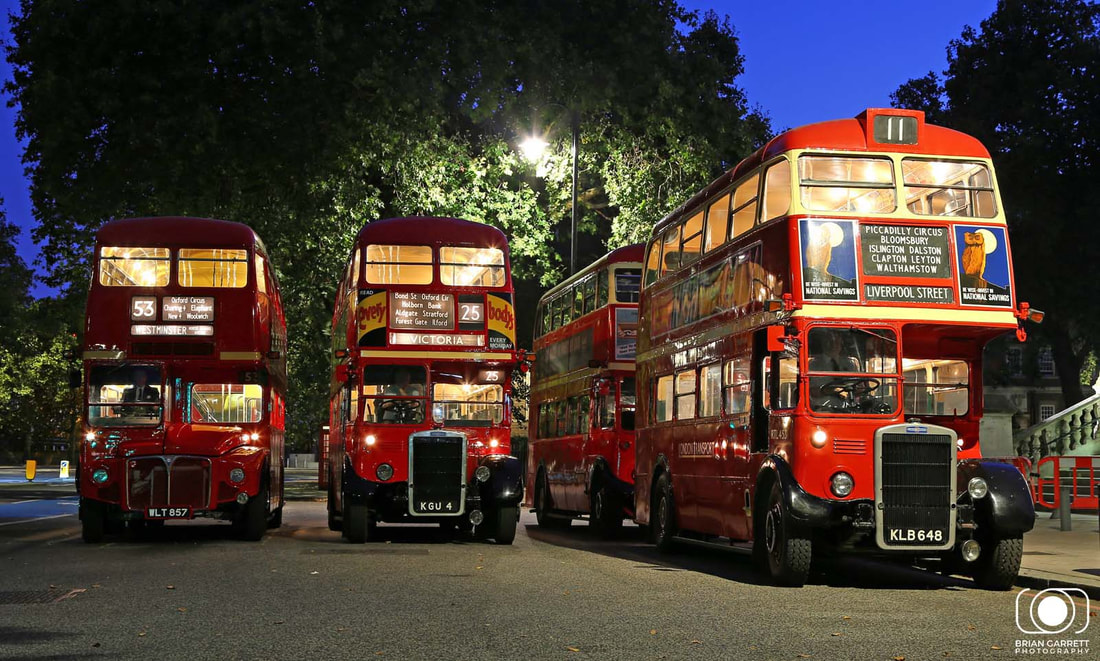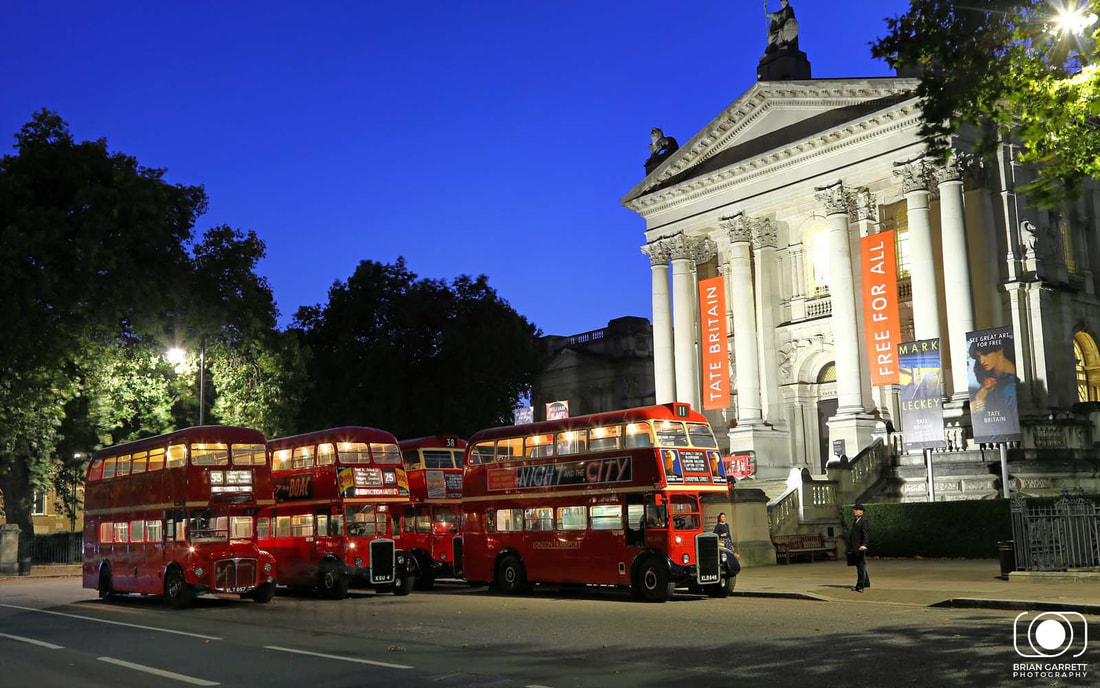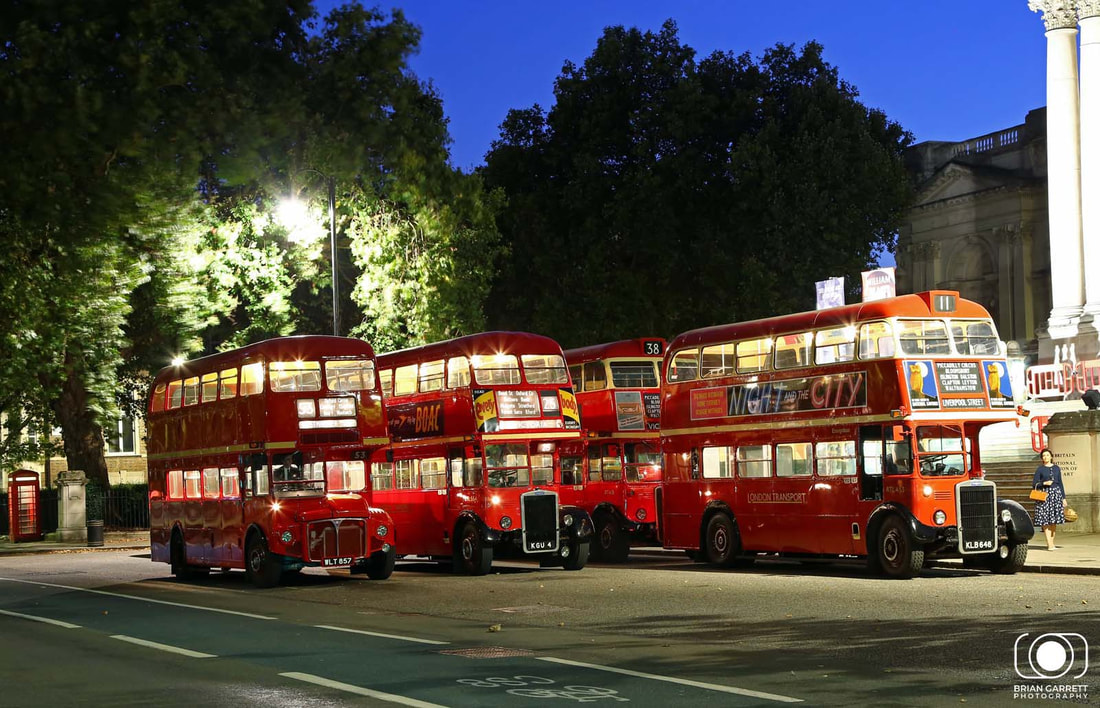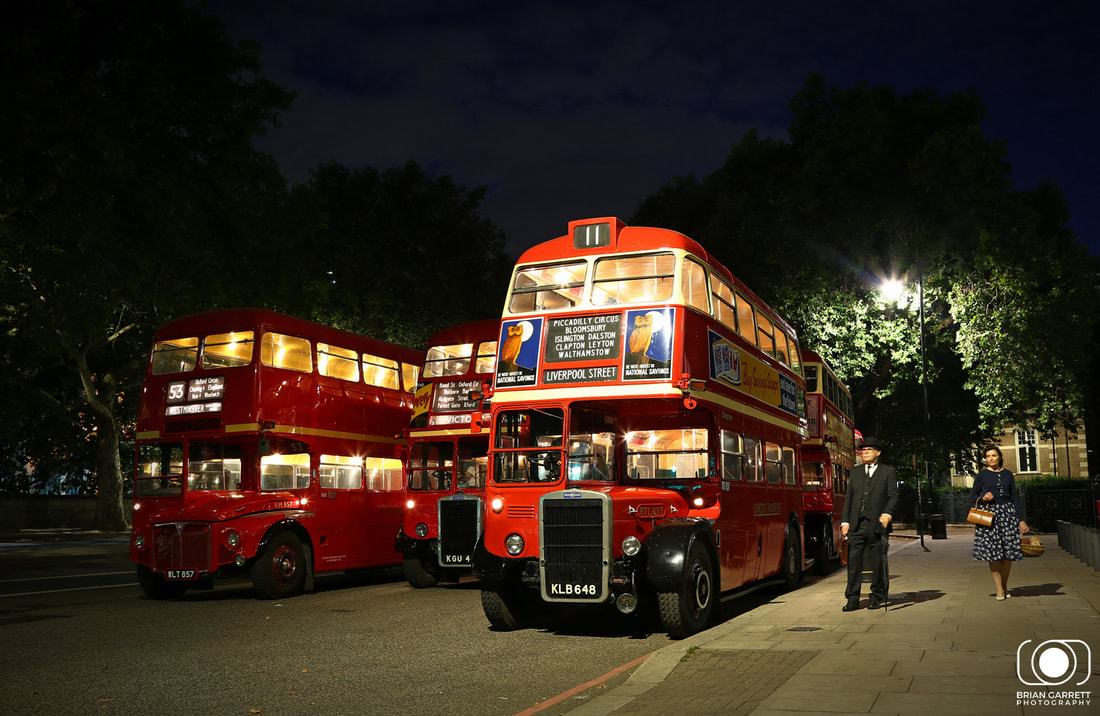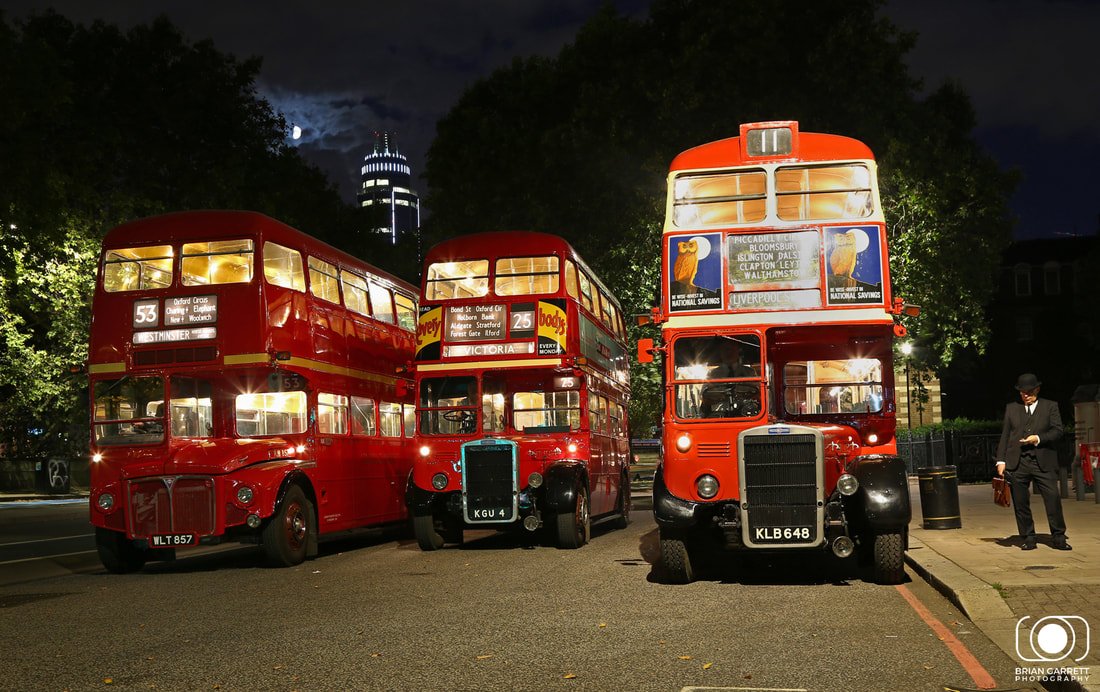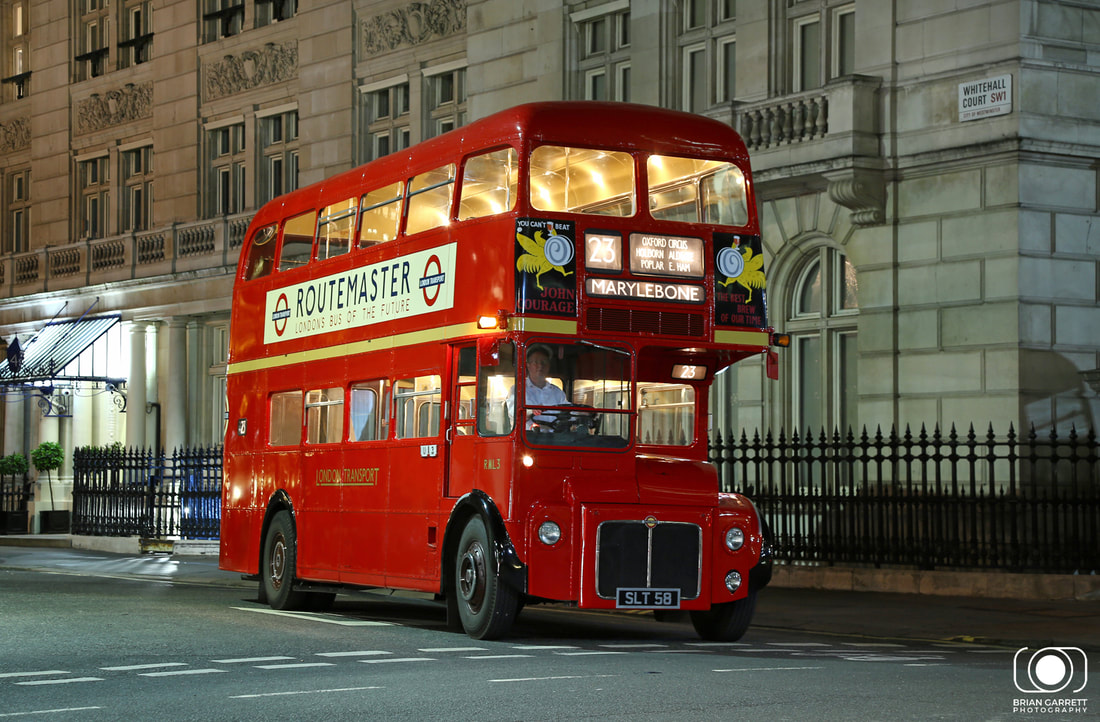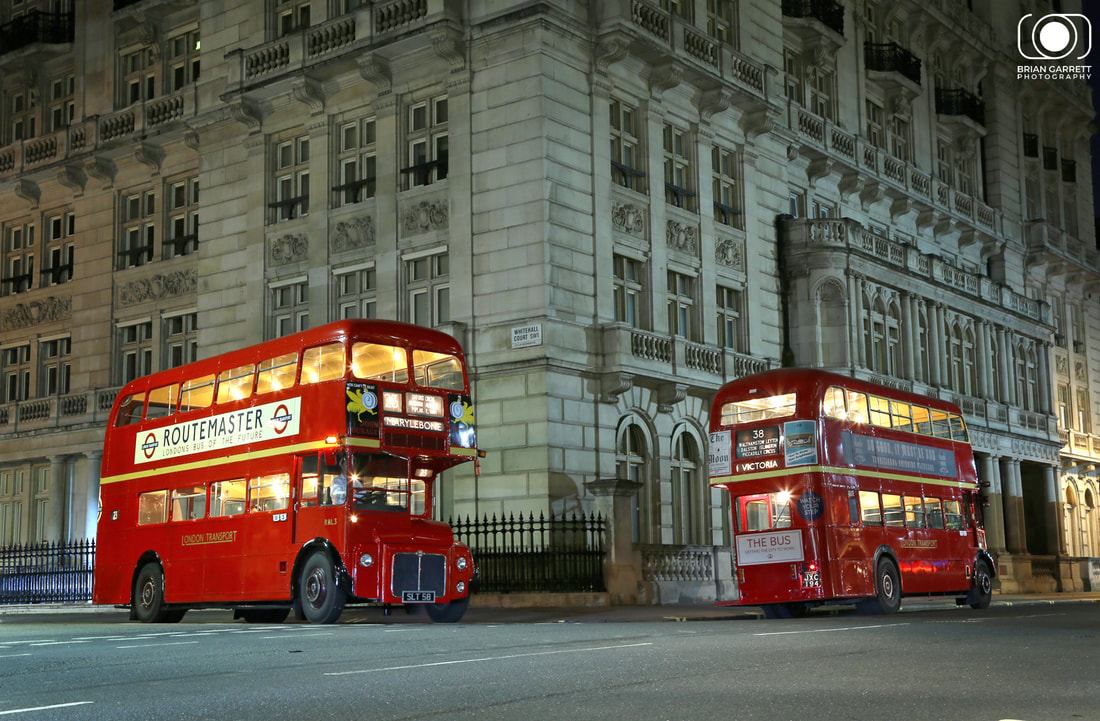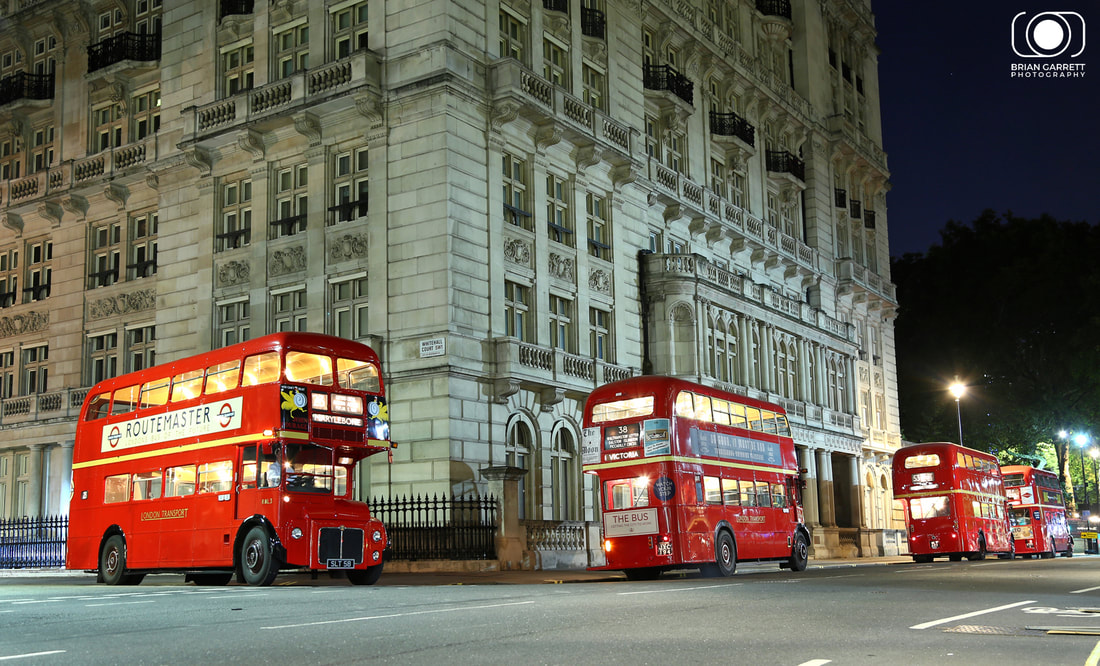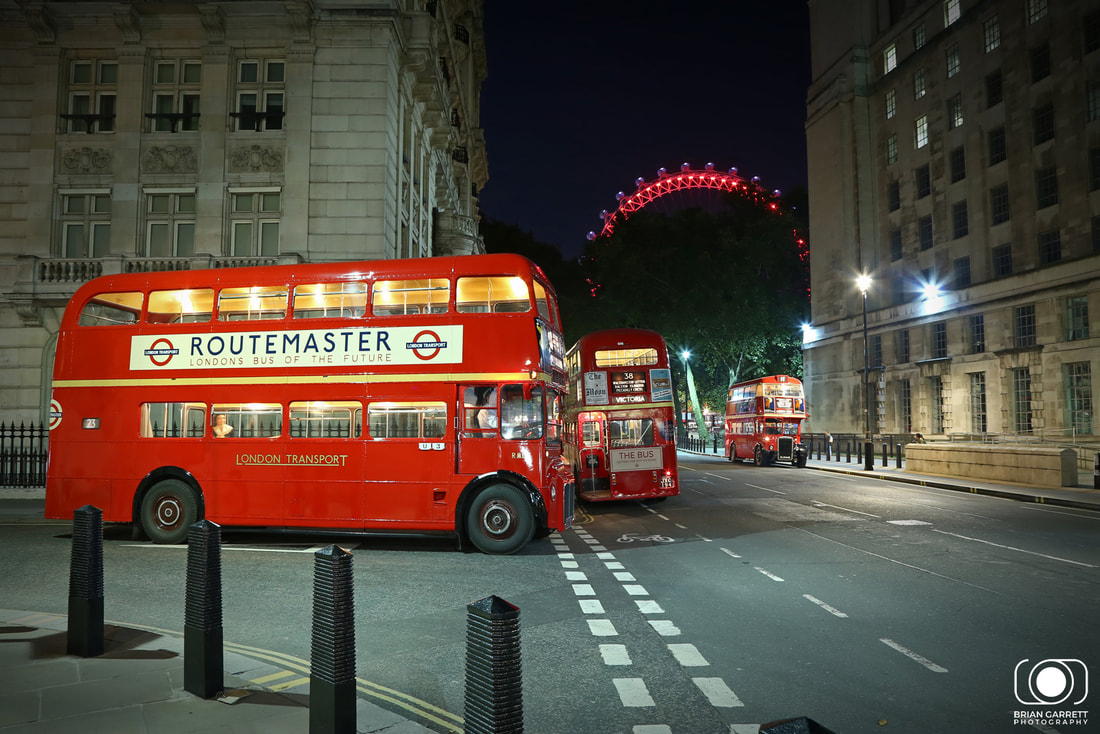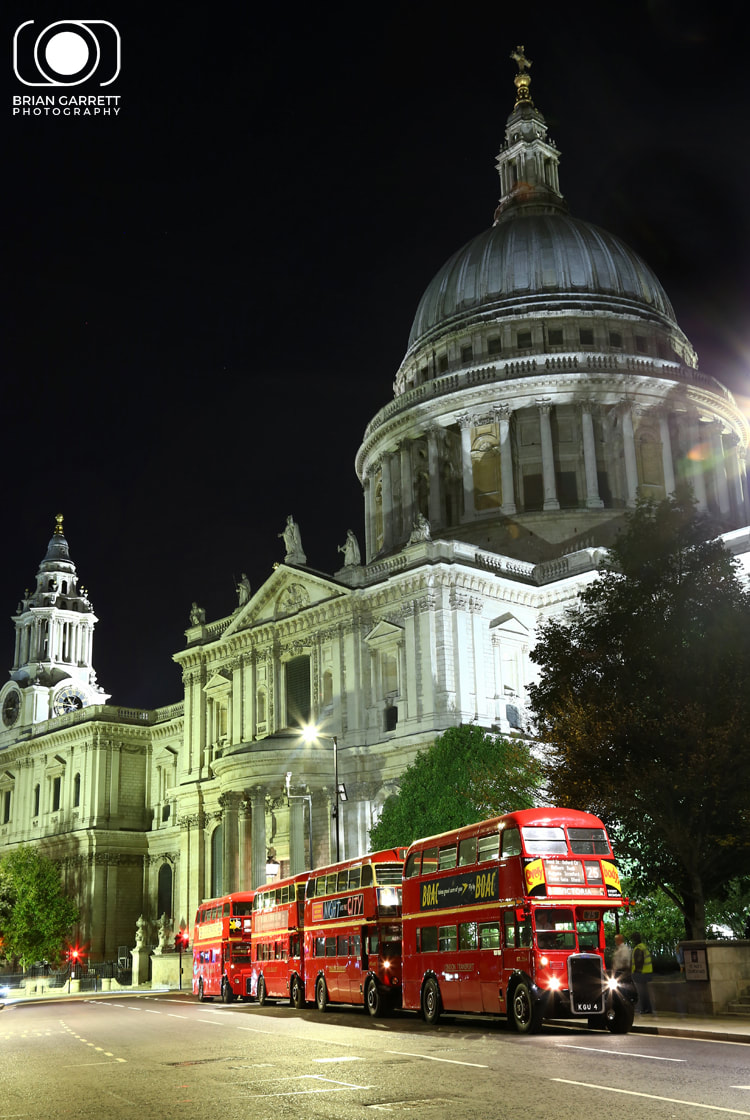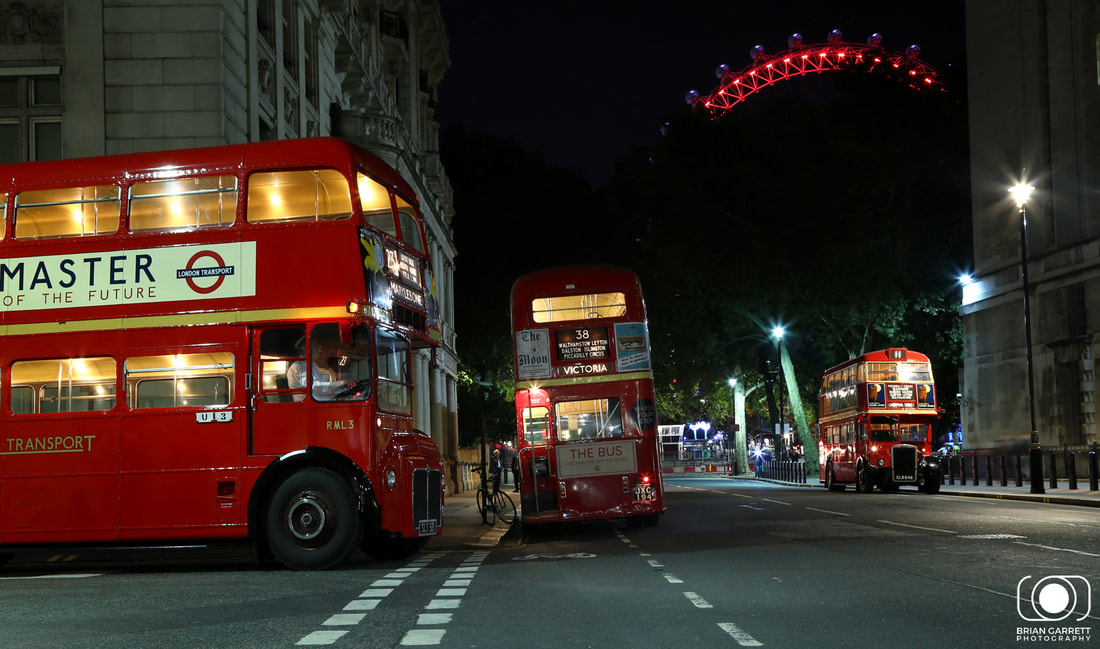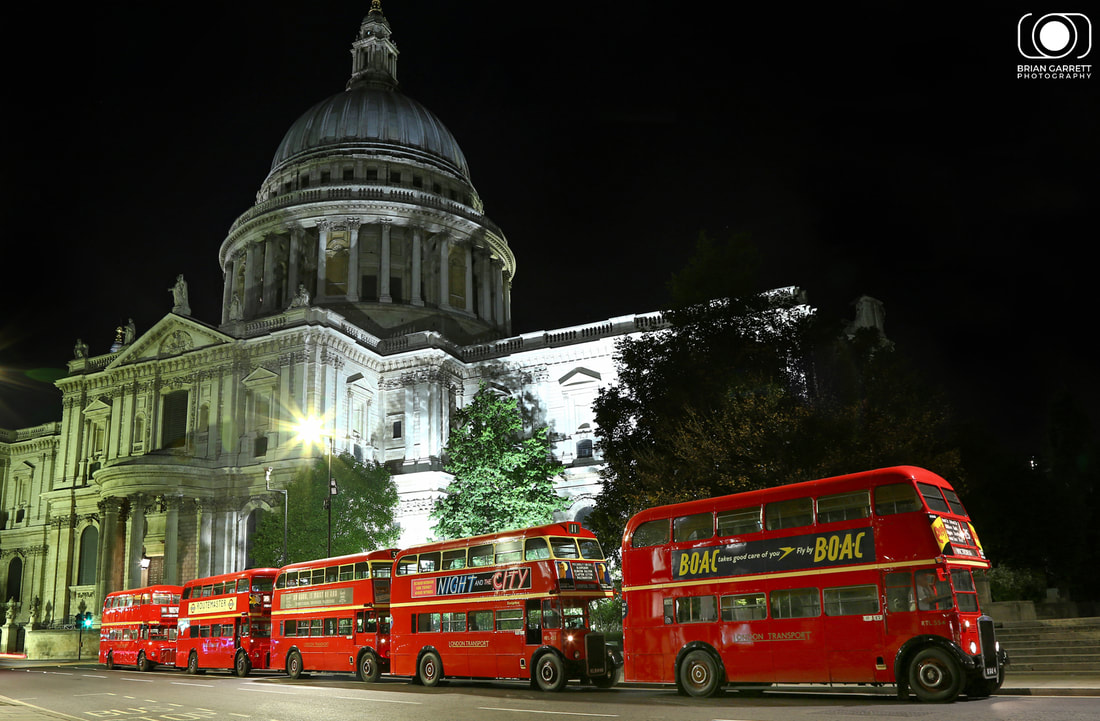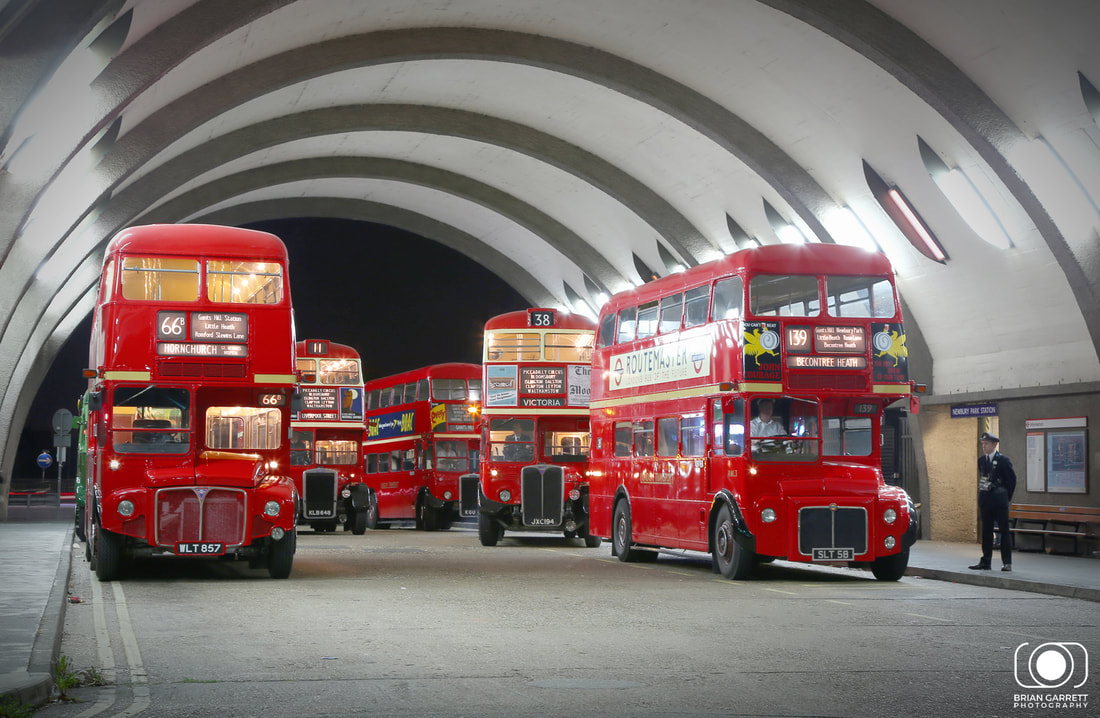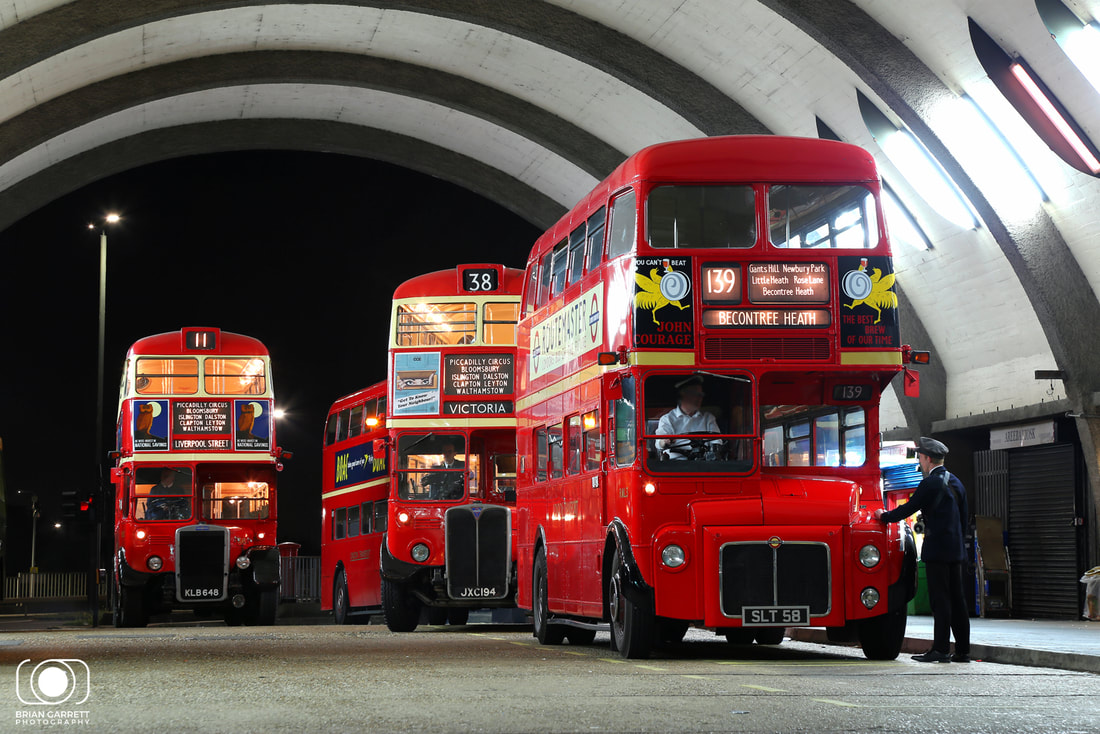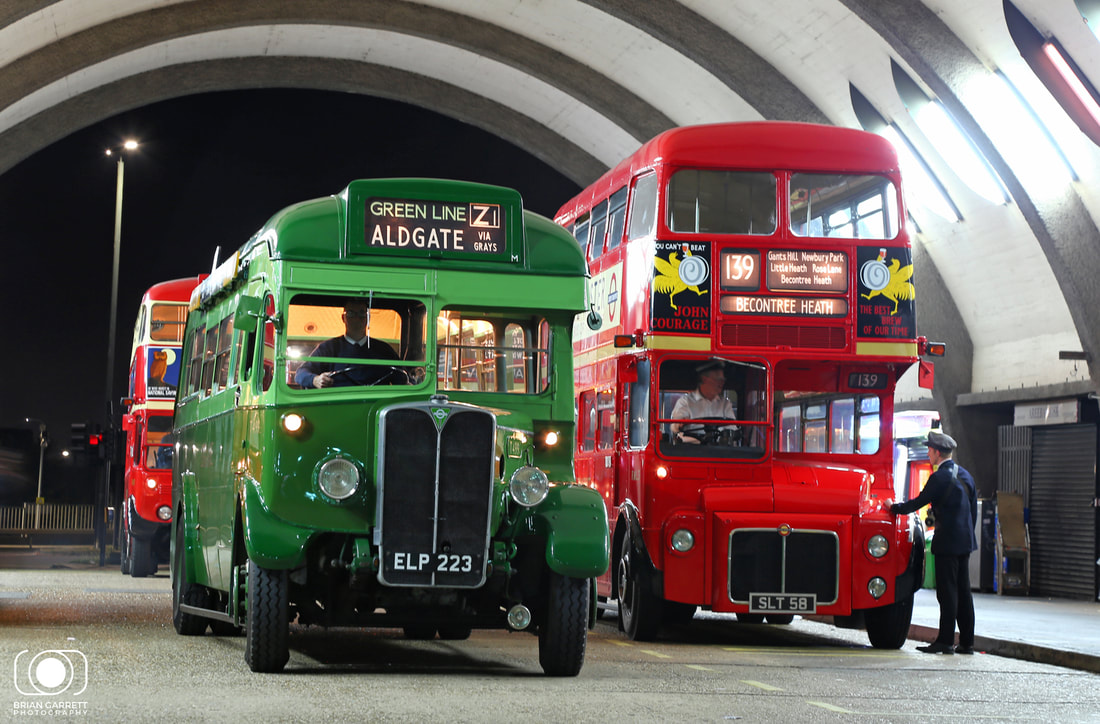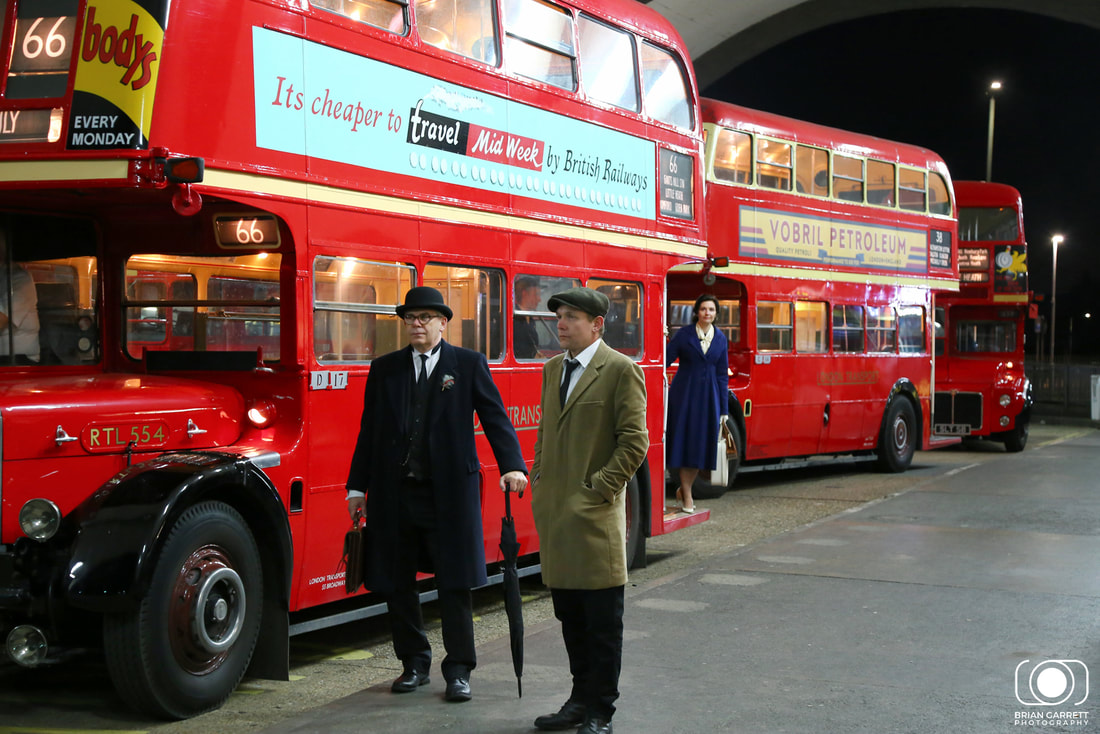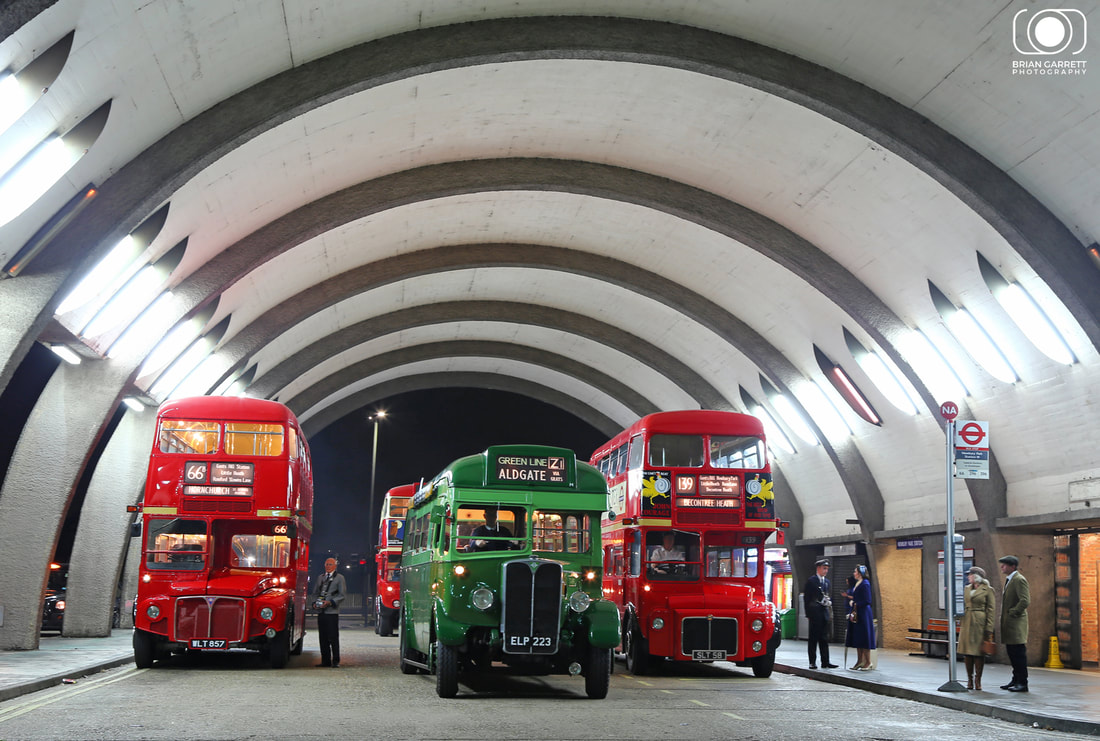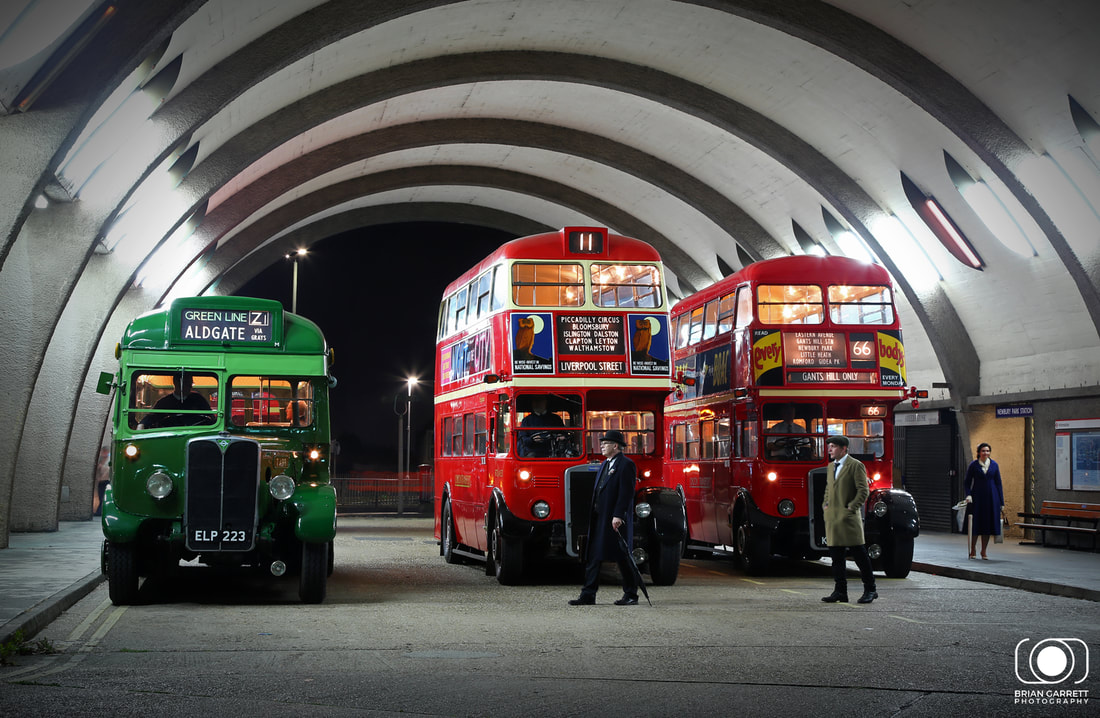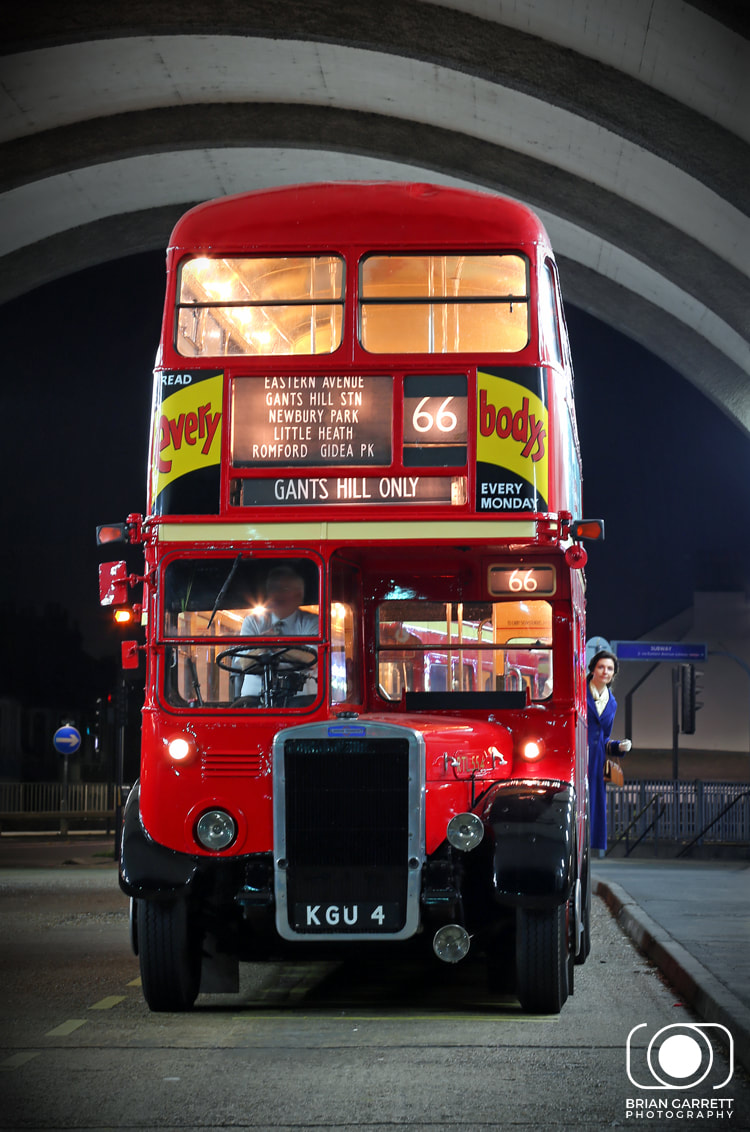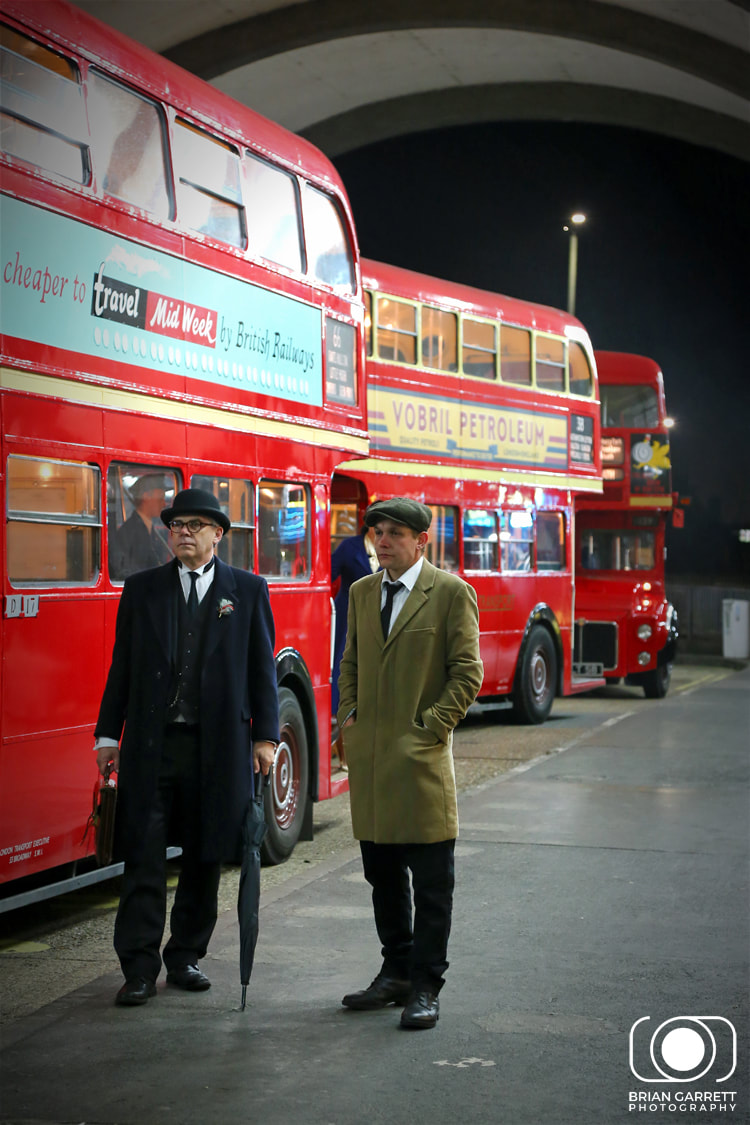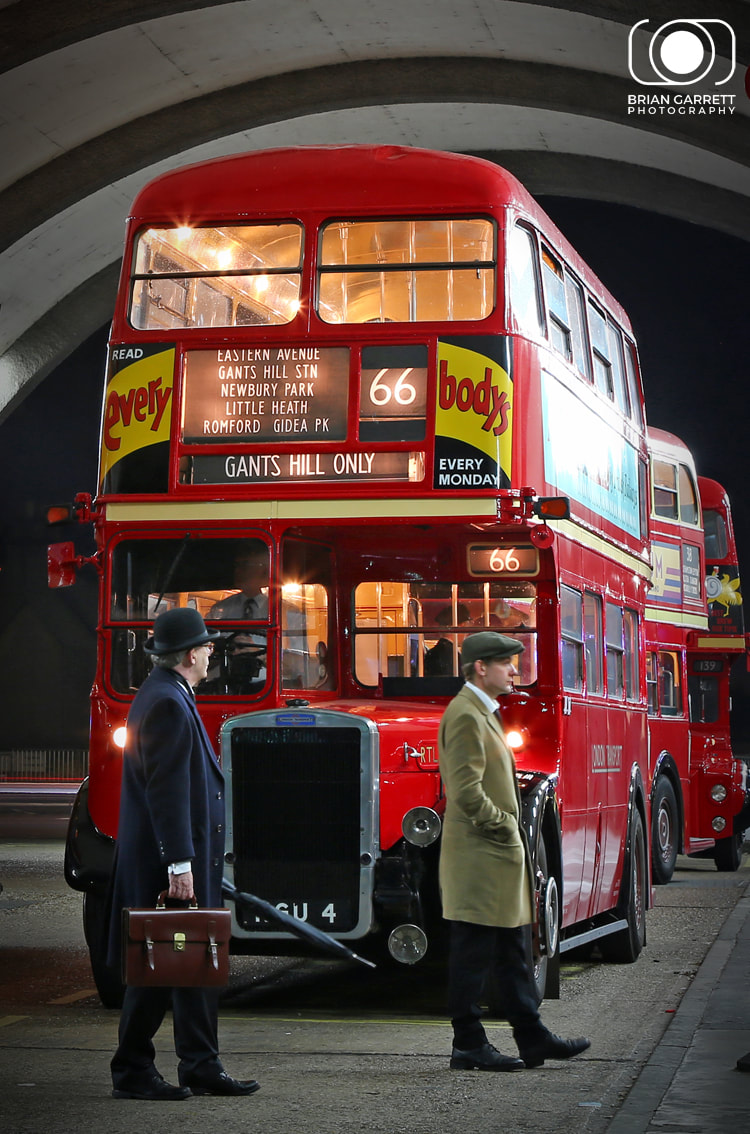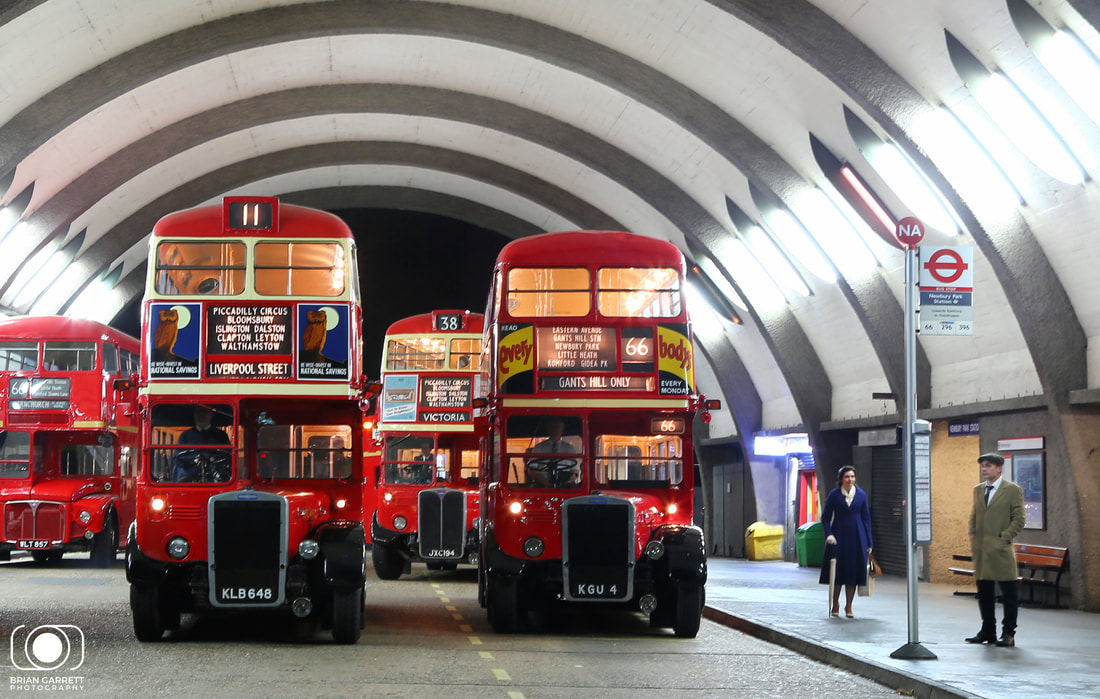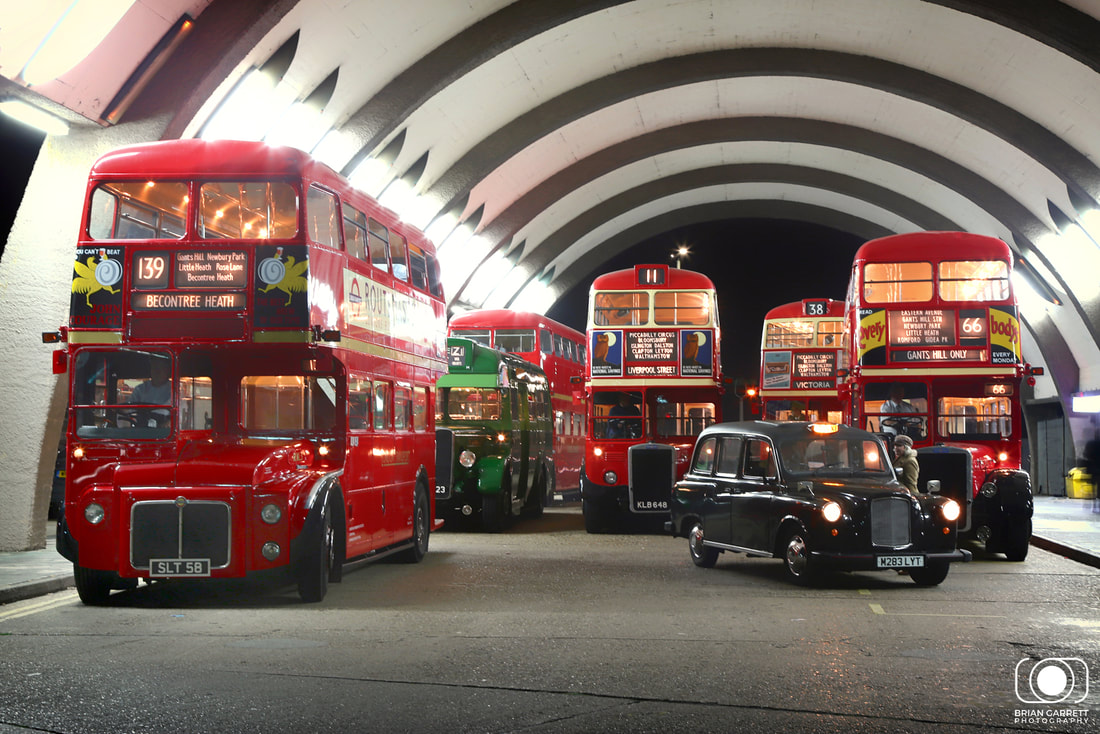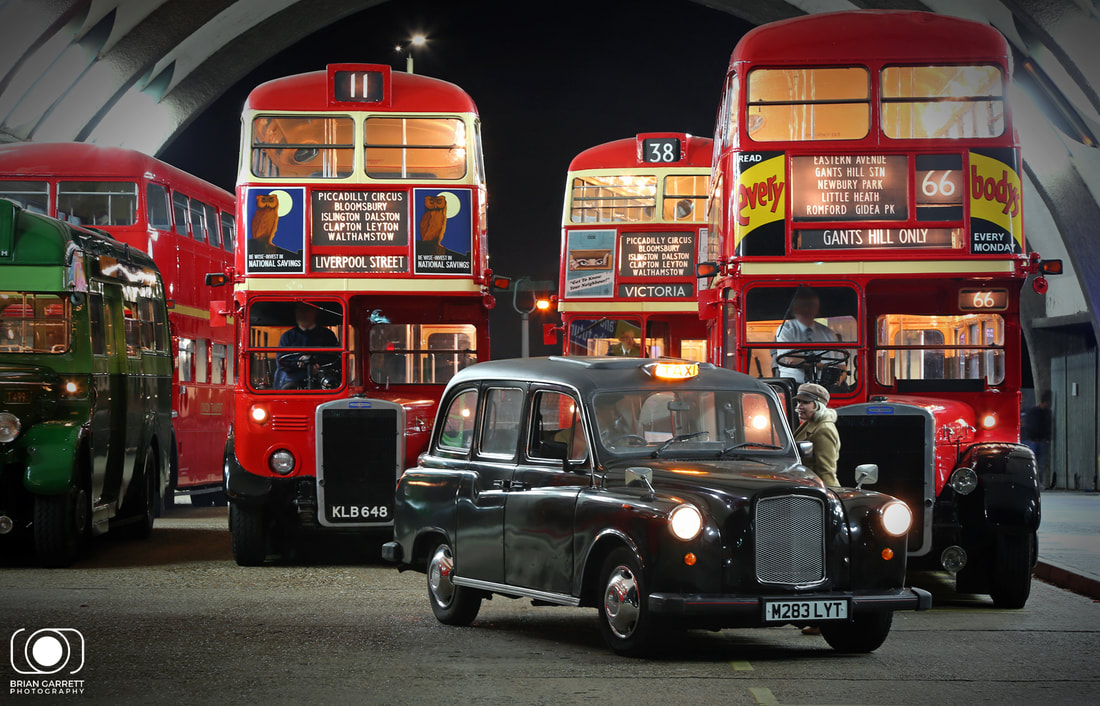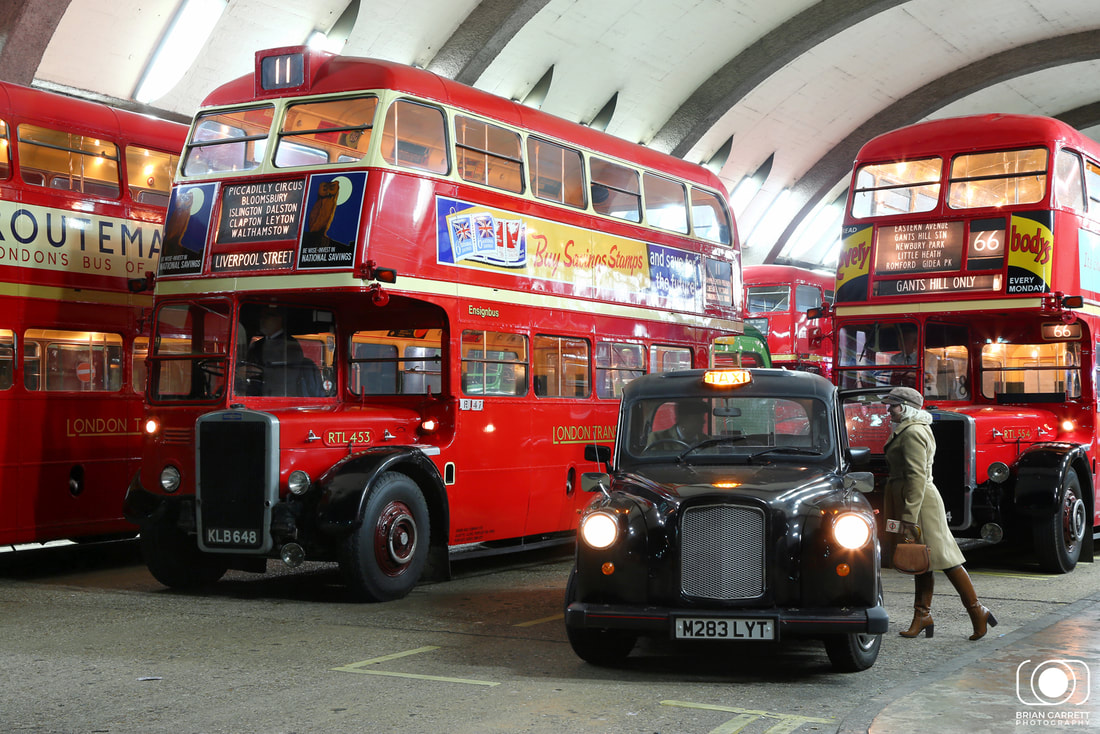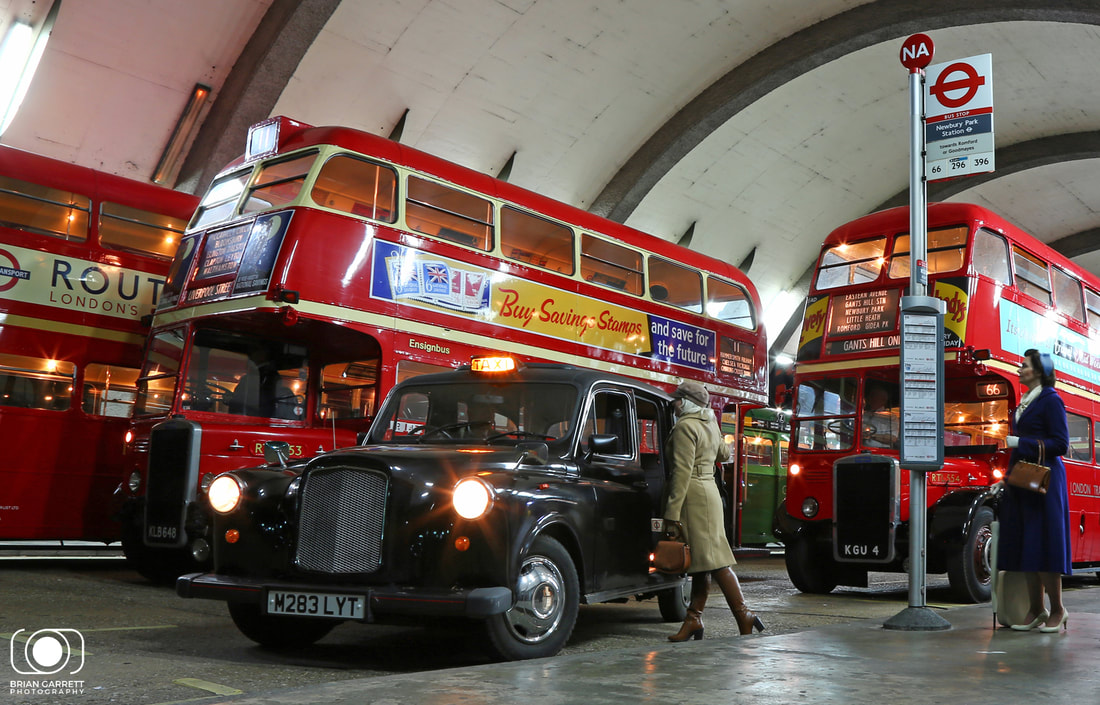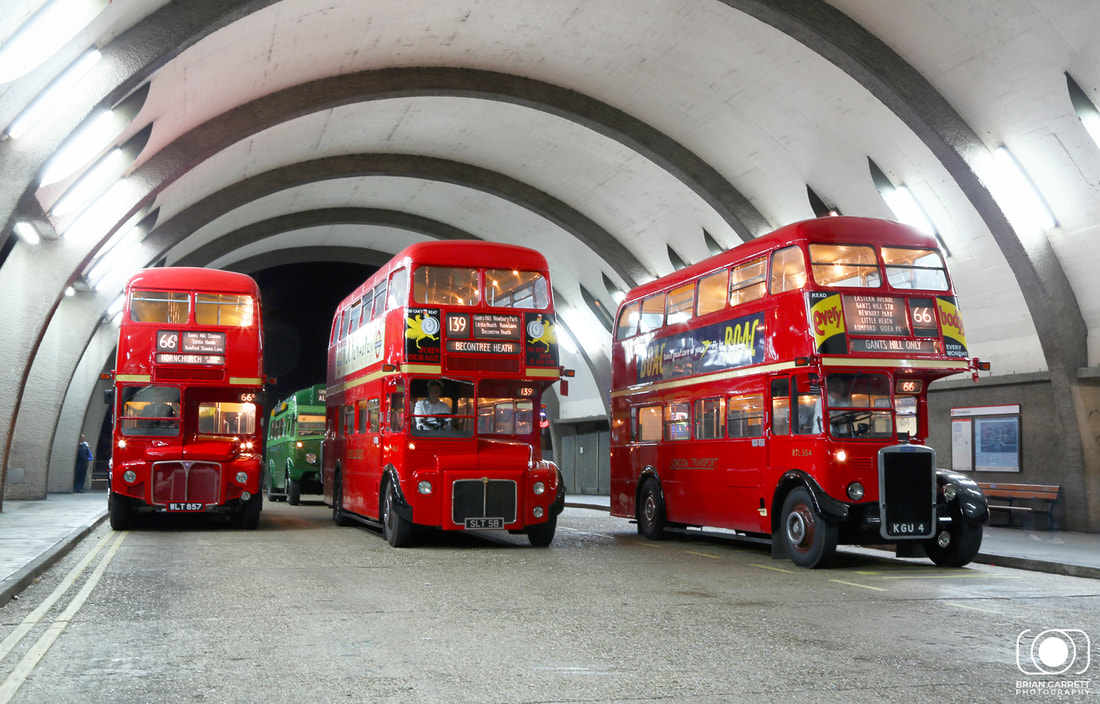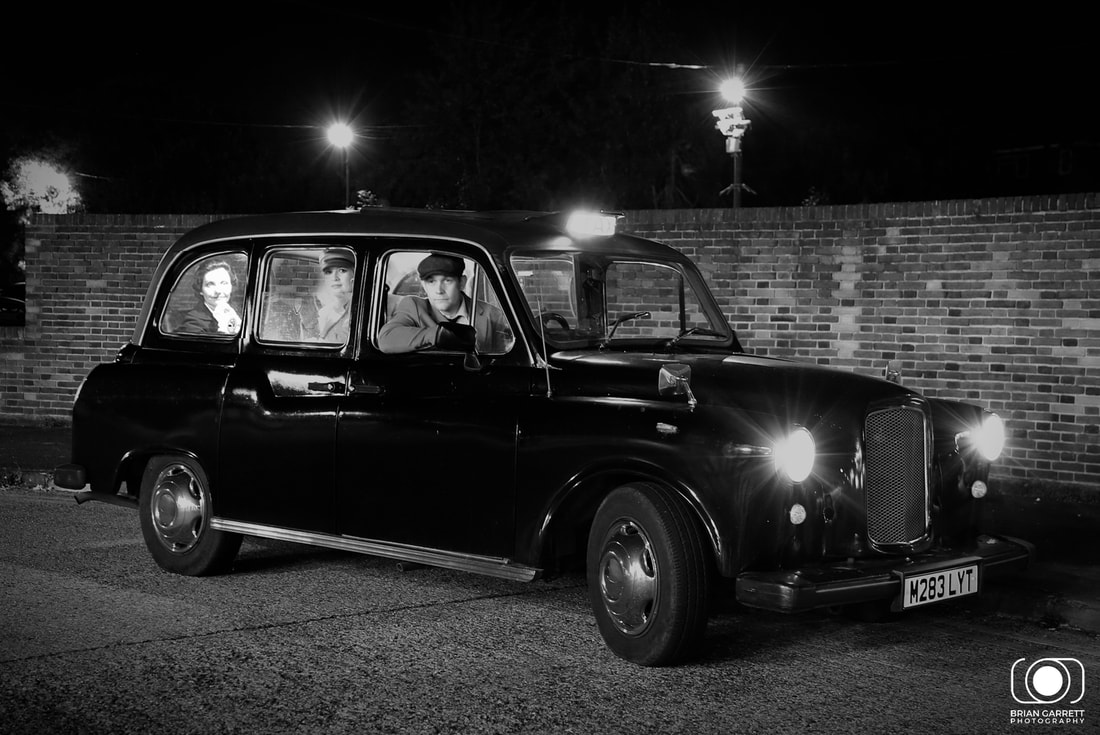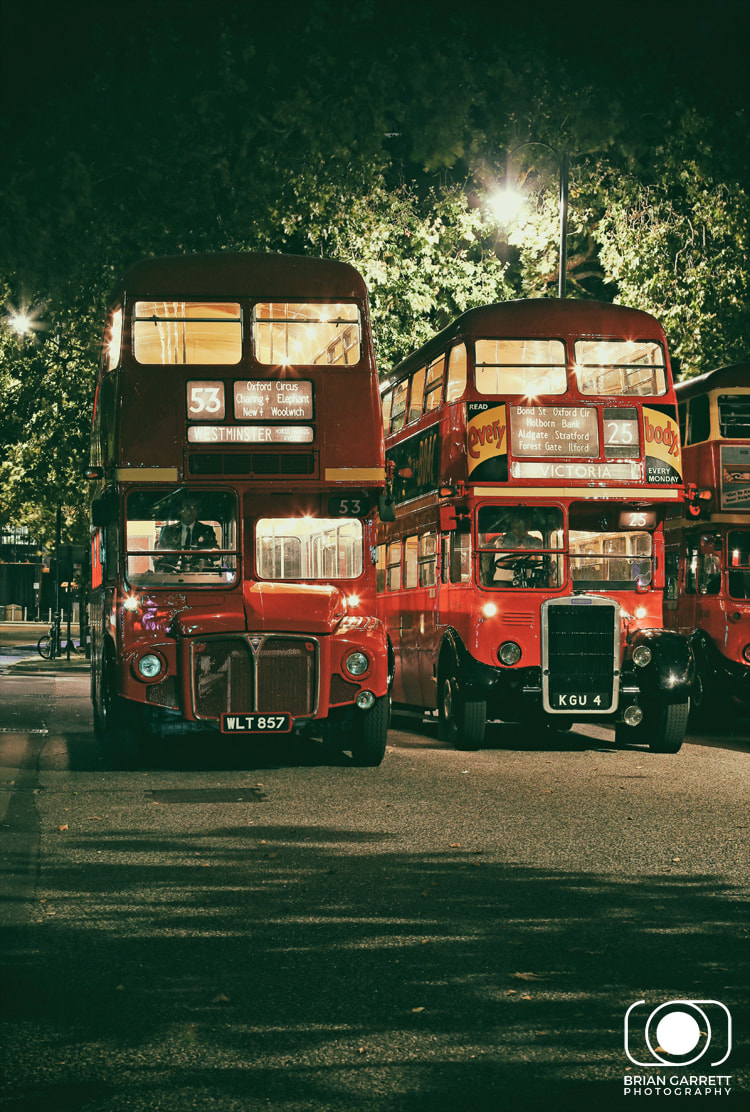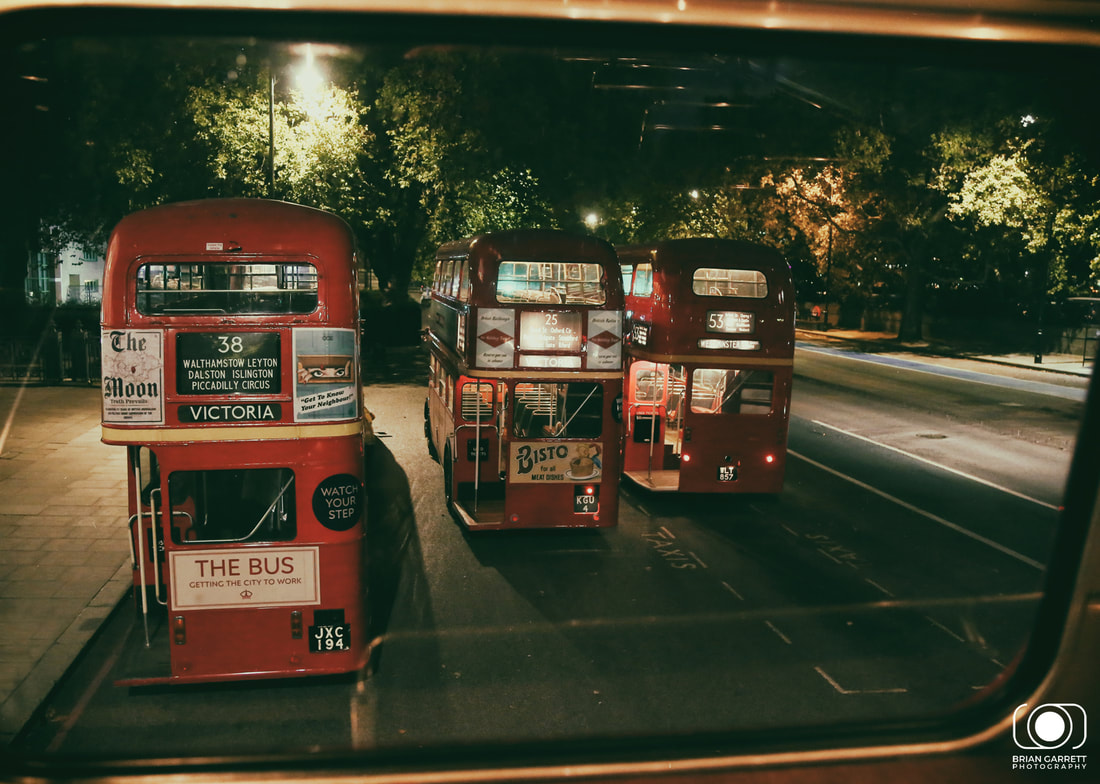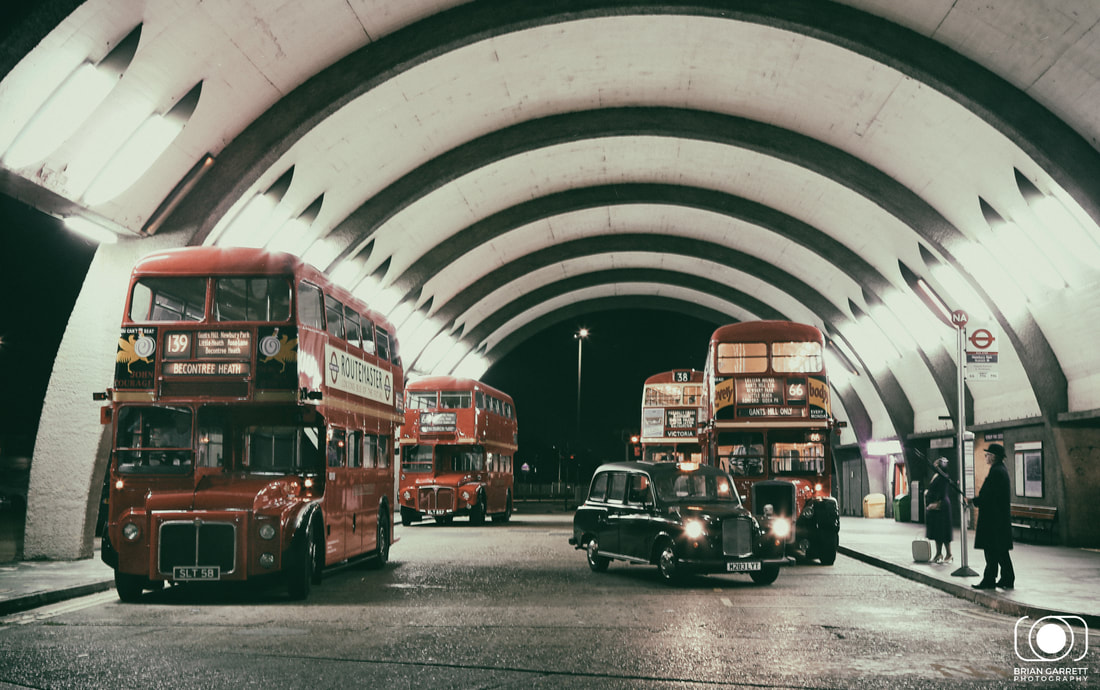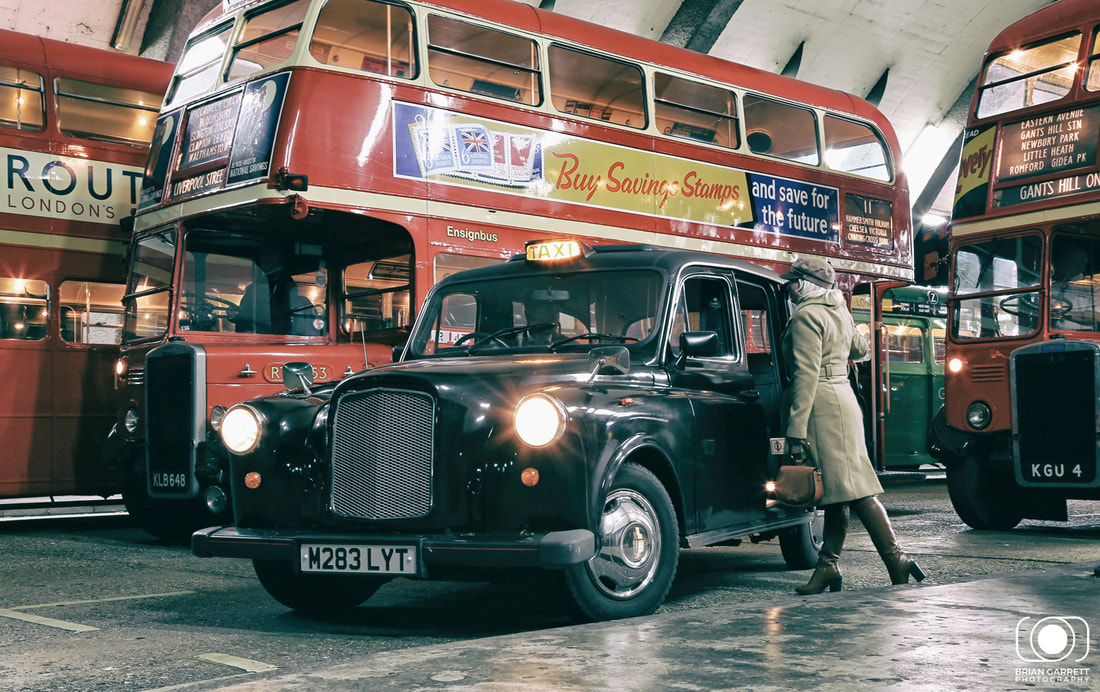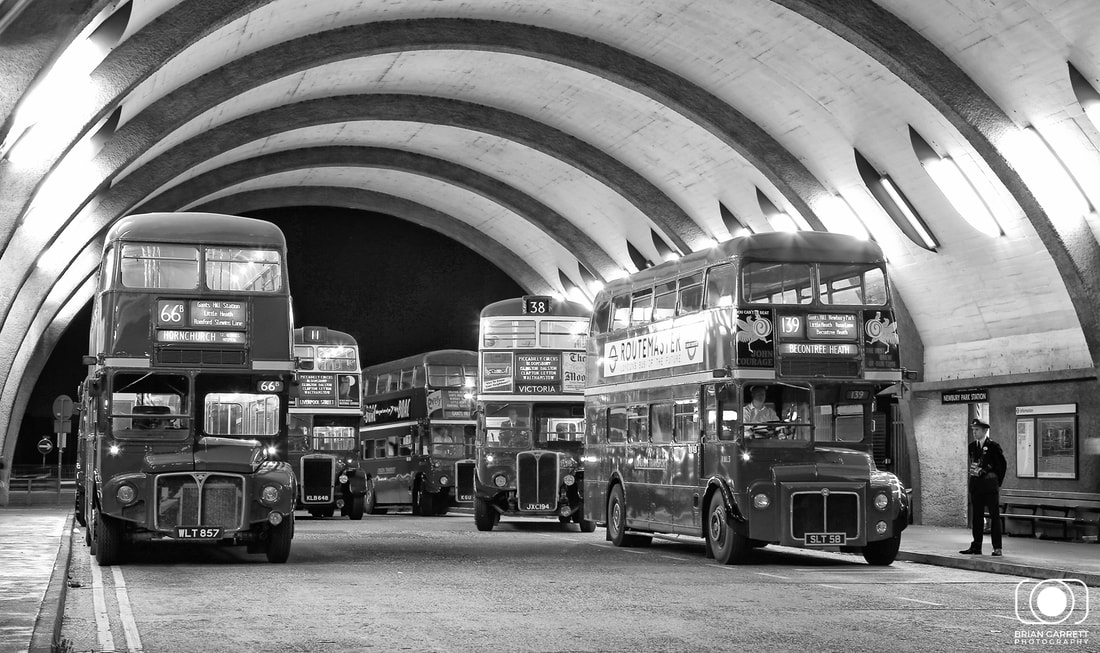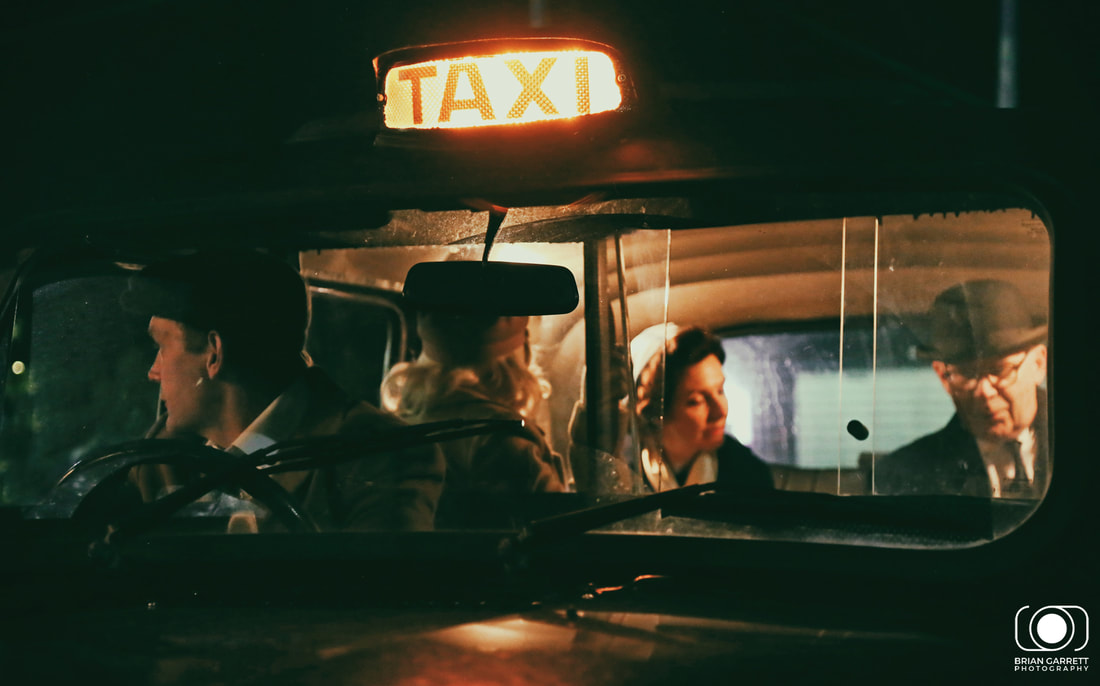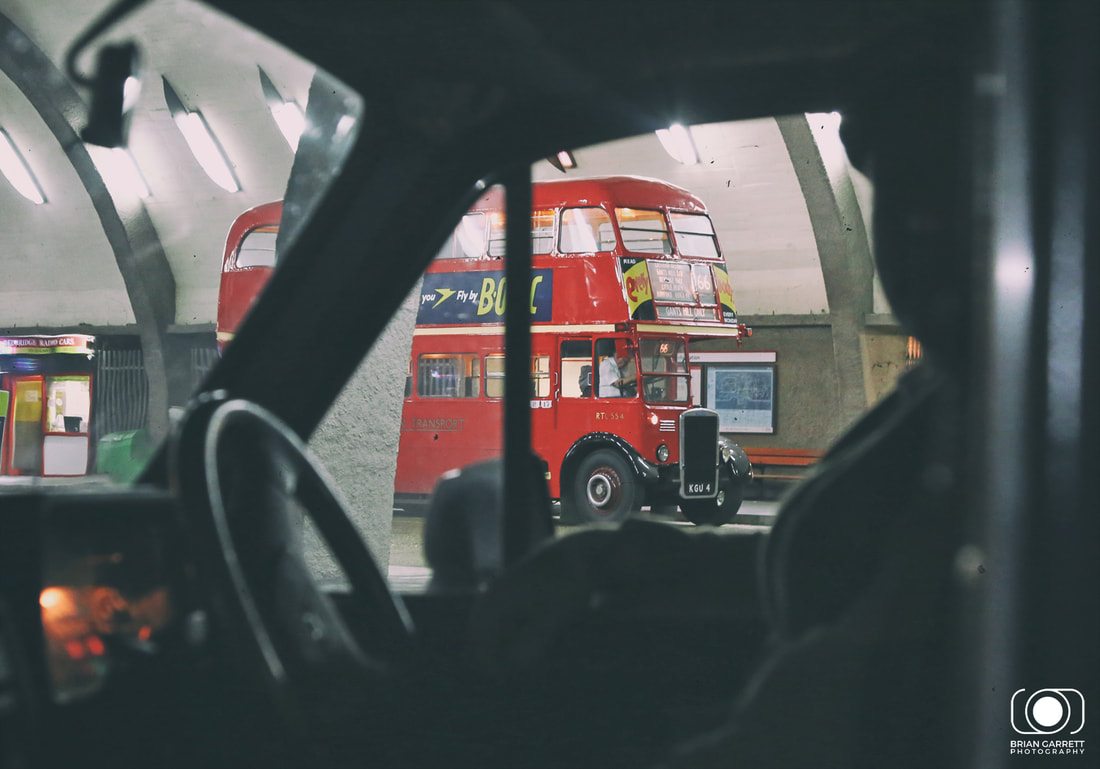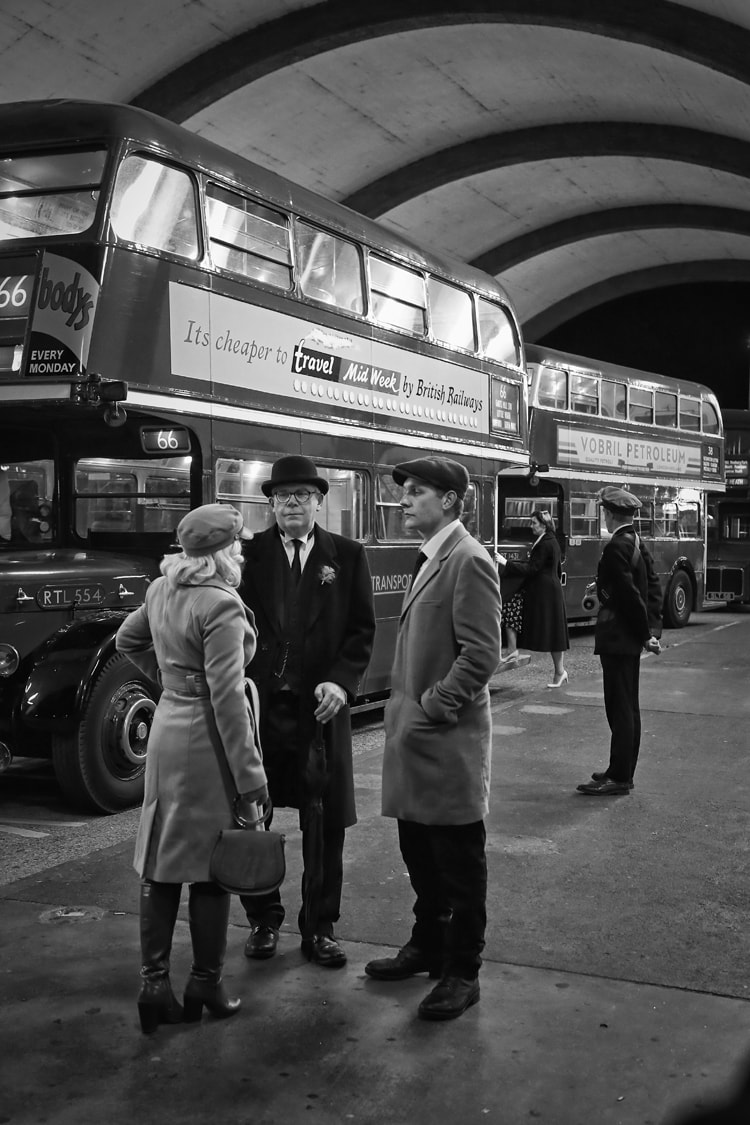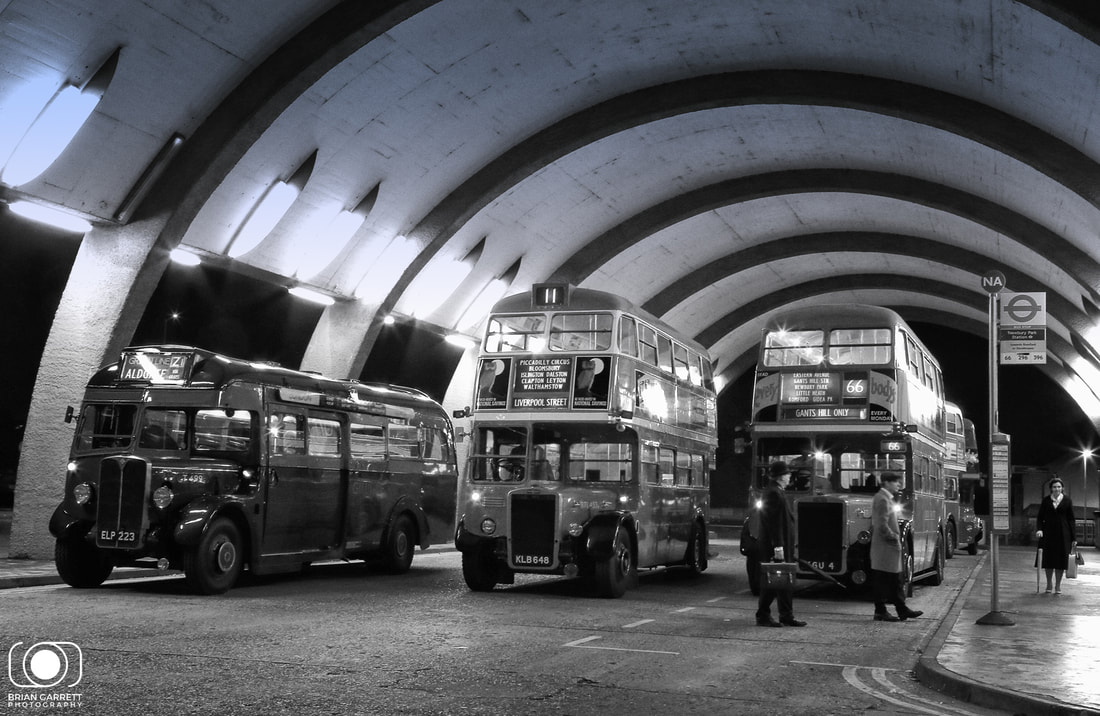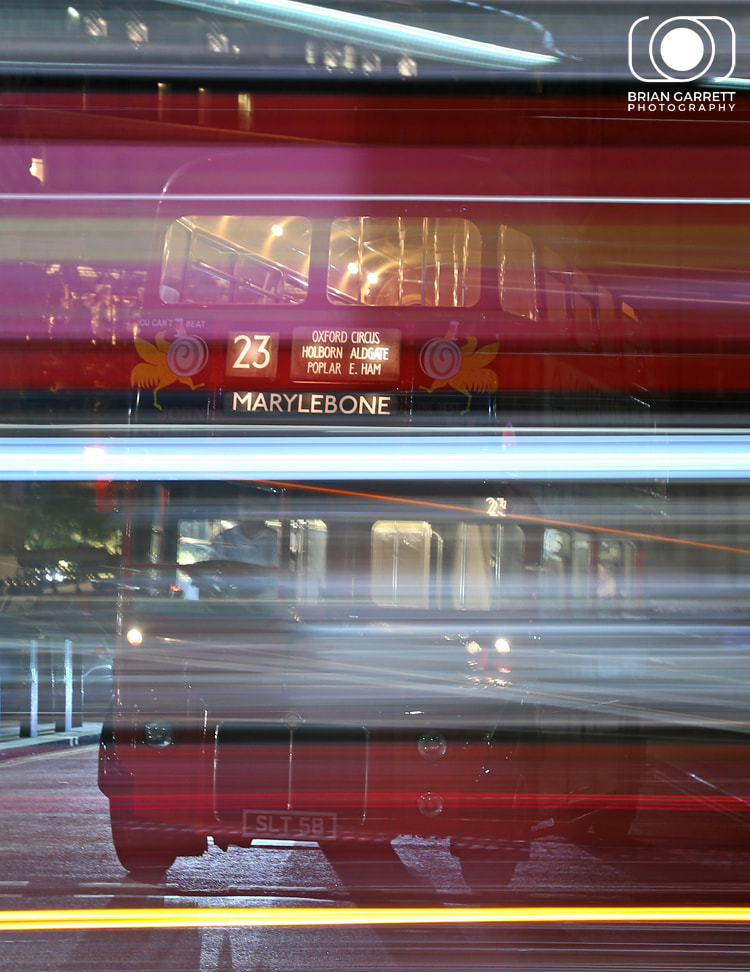London Buses at Night - 7th September 2019
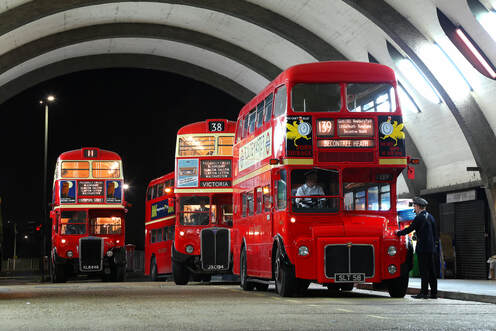
The 7th September 2019 was the date set for the postponed Timeline Events photographic charter. The event started at the Brooklands London Bus Museum where RM3 was provided to transport photographers into Central London. Once in London we would meet up with four other Heritage London Buses supplied from Ensignbus. This was the largest amount of buses ever taken into London at the same time and provided the change to capture busy scenes on the London Streets overnight. The photographic locations used for this shoot were the Tate Britain, Horse Guards Avenue, St Pauls Cathedral and Newbury Park Tube Station (near Illford). Once at Newbury Park the convoy of red London Buses was also joined by a recently refurbished Black London Taxi Cab and a historic Greenline Coach.
The event started at 18:45 on Saturday 7th September 2019 and ended at 03:50 on Sunday morning back at Brooklands.
The event started at 18:45 on Saturday 7th September 2019 and ended at 03:50 on Sunday morning back at Brooklands.
Vehicles which attended the photographic event:
KLB648 - RTL453: This Leyland PD2 was new to London Transport in December 1949, first entering service at Plumstead where it largely operated the 53s. By 1957 it was at Riverside Garage, where route 11 and 88 were two that it would frequent.
JXC194 - RT1431: This AEC Regent had full life. It was new to Nunhead (AH) in May 1949, then served with Uxbridge (UX) and Middle Row (X) before finishing its days at Stockwell (SW) where it was put into store very early on, in August 1955.
It was sold to legendary dealer Birds in April 1956, just as its sister vehicles were culled in their prime. It was then quickly snapped up by Kerr and Linney of the Ayrshire A1 Service co-operative and ran with them for ten years. Its rarity led it to become one of the earlier buses bought for preservation, by the London Omnibus Traction Society in 1966. Since then, it has had several changes of owner – in 1983 it made a mammoth treck to up to the far north, to Orkney. By the 1990s it had migrated to Southport and looked resplendent inside and out, in late 1940s cream-top livery, with period adverts all round. It later passed to Keith Rose, who lived quite close to Cobham and he reunited it with the only other survivor. It was from here that Ensign acquired the vehicle and quickly set to work restoring RT1431 back to passenger carrying duties. It debuted back on a regular London route in normal service, the route 36 as a special guest vehicle to mark the passing of crew operation from this route as the Routemasters were withdrawn.
WTL857 - RM857: The bus was originally built in July 1961 and is based precisely on the look of the bus when it operated along route 11 in 1966. It is now privately owned and regularly features at vintage transport events across the UK
KGU4 - RTL554: The Leyland Titan was built mainly for the UK market between 1927 and 1942, and between 1945 and 1969. The type was widely used in the United Kingdom and it was also successful in export markets, with numerous examples shipped to Australia, Ireland, India, Spain, South Africa and many other countries. From 1946 specific export models were introduced, although all Titans were right-hand drive regardless of the rule of the road in customer countries.
SLT58 - RM3: This is one of four prototype Routemasters built and tested between 1954-1958 before full-scale production began. It was taken into stock in July 1957 and entered service in January 1958, allocated to Willesden garage for use on route 8 into and across central London. One of the two prototypes to have a Leyland engine, it became the only Routemaster to have a body built by Weymann of Weybridge/Addlestone in Surrey at their now long-gone factory just up the road from the London Bus Museum at Brooklands.
ELP223 - T499: T499 was the 46th 10T10 built and was a little bit experimental have a darker green interior and 33 seats she was delivered to Grays garage on June 30, 1938 where she took up duties the following day on the Z series of routes running from Grays, through East London and into Aldgate. In November 1938 she moved to Watford before early in 1939 again moving this time to Hatfield. The war interrupted her commuter career and in September 1939 she became an ambulance and was based at Hendon where she would have had a busy time working throughout the Blitz in recovering casualties from all over London. She was returned to London Transport by August 1945 and in March the following year was a Windsor bus before having her final stint as a passenger carrier at Staines and then going into store awaiting a buyer. She was purchased by W. North’s (dealer) of Leeds Yorkshire on the 15 April 1954 and was sold to Mr Creasey of Perth Western Australia for use as a school bus. For nearly the next decade shoe plied her trade as a school bus near Mt Barker before eventually being sold in 1962 for conversion into a camper. Fortunately this conversion never took place as surely much of the original interior would have been stripped out and T499 sat on a farm forlorn and forgotten about until 1997 when she was discovered by a group of enthusiasts which led Ian Kerr to move quickly to acquire the vehicle for preservation. Sadly the condition was worse than expected and whilst the vehicle was now safe it remained out of use. The vehicle was kindly donated to the Ensign collection in 2004 and it returned to the UK in December of that year. Following a wait in the ‘queue’ of vehicles work began on restoring her in February 2011, and she was eventually recertified on November 29, 2013. She debuted on the road a week later carrying passengers in the UK for the first time in 60 years wearing for ‘one day only’ the drab grey livery of the American Red Cross before she receives her original three tone green livery in 2014.
M283LYT - London Taxi: The FX4 London taxi was the successor to the Austin FX3, which was produced between 1948 and 1958. In its day the FX3 was the most widely used taxi in London. ... The first FX4, registration number VLW 431, was delivered in July 1958 and production went on until 1997. M283LYT has recently been restored and returned to service by a Claire Pamela Hack (who is also one of the Timeline Events Reinactors, the Taxi is now named 'Betsy'.
KLB648 - RTL453: This Leyland PD2 was new to London Transport in December 1949, first entering service at Plumstead where it largely operated the 53s. By 1957 it was at Riverside Garage, where route 11 and 88 were two that it would frequent.
JXC194 - RT1431: This AEC Regent had full life. It was new to Nunhead (AH) in May 1949, then served with Uxbridge (UX) and Middle Row (X) before finishing its days at Stockwell (SW) where it was put into store very early on, in August 1955.
It was sold to legendary dealer Birds in April 1956, just as its sister vehicles were culled in their prime. It was then quickly snapped up by Kerr and Linney of the Ayrshire A1 Service co-operative and ran with them for ten years. Its rarity led it to become one of the earlier buses bought for preservation, by the London Omnibus Traction Society in 1966. Since then, it has had several changes of owner – in 1983 it made a mammoth treck to up to the far north, to Orkney. By the 1990s it had migrated to Southport and looked resplendent inside and out, in late 1940s cream-top livery, with period adverts all round. It later passed to Keith Rose, who lived quite close to Cobham and he reunited it with the only other survivor. It was from here that Ensign acquired the vehicle and quickly set to work restoring RT1431 back to passenger carrying duties. It debuted back on a regular London route in normal service, the route 36 as a special guest vehicle to mark the passing of crew operation from this route as the Routemasters were withdrawn.
WTL857 - RM857: The bus was originally built in July 1961 and is based precisely on the look of the bus when it operated along route 11 in 1966. It is now privately owned and regularly features at vintage transport events across the UK
KGU4 - RTL554: The Leyland Titan was built mainly for the UK market between 1927 and 1942, and between 1945 and 1969. The type was widely used in the United Kingdom and it was also successful in export markets, with numerous examples shipped to Australia, Ireland, India, Spain, South Africa and many other countries. From 1946 specific export models were introduced, although all Titans were right-hand drive regardless of the rule of the road in customer countries.
SLT58 - RM3: This is one of four prototype Routemasters built and tested between 1954-1958 before full-scale production began. It was taken into stock in July 1957 and entered service in January 1958, allocated to Willesden garage for use on route 8 into and across central London. One of the two prototypes to have a Leyland engine, it became the only Routemaster to have a body built by Weymann of Weybridge/Addlestone in Surrey at their now long-gone factory just up the road from the London Bus Museum at Brooklands.
ELP223 - T499: T499 was the 46th 10T10 built and was a little bit experimental have a darker green interior and 33 seats she was delivered to Grays garage on June 30, 1938 where she took up duties the following day on the Z series of routes running from Grays, through East London and into Aldgate. In November 1938 she moved to Watford before early in 1939 again moving this time to Hatfield. The war interrupted her commuter career and in September 1939 she became an ambulance and was based at Hendon where she would have had a busy time working throughout the Blitz in recovering casualties from all over London. She was returned to London Transport by August 1945 and in March the following year was a Windsor bus before having her final stint as a passenger carrier at Staines and then going into store awaiting a buyer. She was purchased by W. North’s (dealer) of Leeds Yorkshire on the 15 April 1954 and was sold to Mr Creasey of Perth Western Australia for use as a school bus. For nearly the next decade shoe plied her trade as a school bus near Mt Barker before eventually being sold in 1962 for conversion into a camper. Fortunately this conversion never took place as surely much of the original interior would have been stripped out and T499 sat on a farm forlorn and forgotten about until 1997 when she was discovered by a group of enthusiasts which led Ian Kerr to move quickly to acquire the vehicle for preservation. Sadly the condition was worse than expected and whilst the vehicle was now safe it remained out of use. The vehicle was kindly donated to the Ensign collection in 2004 and it returned to the UK in December of that year. Following a wait in the ‘queue’ of vehicles work began on restoring her in February 2011, and she was eventually recertified on November 29, 2013. She debuted on the road a week later carrying passengers in the UK for the first time in 60 years wearing for ‘one day only’ the drab grey livery of the American Red Cross before she receives her original three tone green livery in 2014.
M283LYT - London Taxi: The FX4 London taxi was the successor to the Austin FX3, which was produced between 1948 and 1958. In its day the FX3 was the most widely used taxi in London. ... The first FX4, registration number VLW 431, was delivered in July 1958 and production went on until 1997. M283LYT has recently been restored and returned to service by a Claire Pamela Hack (who is also one of the Timeline Events Reinactors, the Taxi is now named 'Betsy'.

